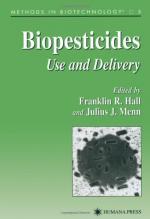|
This section contains 481 words (approx. 2 pages at 300 words per page) |

|
For years, farmers have tried to halt the devastation to their crops caused by insects, weeds, and other pests. Until the twentieth century, they relied on crude mixtures based on poisons such as lead and arsenic. These didn't work on very many crops, and they were dangerous to humans. But they improved the ability of farmers to provide food for a growing population.
The modern era of pesticides began when sophisticated synthetic pesticidesmade by scientists combining chemicals in a laboratory were developed. DDT (dichlorodiphenyltrichloroethane) was first applied during the Second World War. Unlike most previous pesticides, it appeared to pose no harm to humans. It was heralded as a miracle chemical, and started a drive for similar pesticides.
But over the years the use of the new pesticides caused problems, especially because they were applied so extensively. People began to notice that birds died after the chemicals...
|
This section contains 481 words (approx. 2 pages at 300 words per page) |

|



